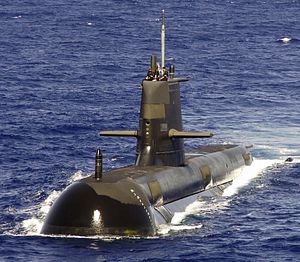As previously reported by the Diplomat, Australia is still trying to figure out which submarines will replace its Collins-class boats. The three contenders still in the so-called SEA-1000 competition are the German ThyssenKrupp’s Type 216-class, a diesel-electric version of the French Thales/DCNS Barracuda-class and a modified version of the Japanese Kawasaki Soryu-class. The first of the 6 Collins’ have been in service since the early 1990s, when they replaced the venerable Oberon-class. Although no definitive price limit has been set, the Collins replacement program has caused an intense debate in Australia, and is calculated to be the most expensive defense acquisition in country’s history.
One of the contenders to be dropped from the competition last year was Sweden’s Saab Kockums. As the Diplomat’s Franz-Stefan Gady reported earlier this year, this was apparently due to Sweden’s inexperience in building advanced subs. Former Prime Minister Tony Abbott stated that “The last Australian submarine came off the production line in about 2001 … the last Swedish submarine came off the production line in 1996, so it’s almost two decades since Sweden built a submarine.”
Saab Kockums responded that “this is not the case” and emphasizes that Sweden, “maintained a full capacity to design and build submarines both for Sweden and for export over the last 20 years.”
Despite being dropped from the original bid, Saab Kockums is now trying to get back in the Australian submarine business. Last week, at the Pacific Maritime Exhibition in Sydney, Gunilla Fransson, senior vice-president of Saab, stated that the Swedish company is offering to provide the Collins with mid-life upgrades in order to keep the submarine competitive: “In Australia, you have decided on a new submarine program, which is fantastic, but it’s not going to be here for a number of years and it is a very big undertaking.”
Kockums (now Saab Kockums) originally designed the Collins-class. It has also designed and built the Swedish Navy’s Gotland-class so the two have common ancestry. (The Gotland-class has also been exported to Singapore as the Challenger-class.)
For its age and small size, the Gotland is quite an impressive sub. Considering that it was launched in the early 1990s, displacing just under 1,500 tones and crewed by around 30 seamen and officers, it might be surprising that the Gotland has been dubbed “Sweden’s little carrier killer.” This nickname was given after a Swedish boat on loan to the U.S. supposedly managed to “sink” the Nimitz-class super-carrier USS Ronald Reagan during exercises in the Pacific, without being discovered.
Two of Sweden’s three Gotland-class subs are due for a mid-life upgrade, to be completed 2018-2019. This entails that many important systems, such as sonars and the fire management systems will be fully replaced. Perhaps most interestingly, the subs will also receive upgrades to their Stirling Air-Independent Propulsion system (AIP.) It is this engine, combined with the Gotland’s small size which allowed it to penetrate the Ronald Reagan’s Anti-Submarine Perimeter, “sink” it, and get away unnoticed.
According to Saab Kockums, the Collins-class could receive similar upgrades as the Gotland-boats. This could be carried out in collaboration with the Australian Submarine Corp. in Australia, an important aspect in Canberra’s SEA-1000 considerations.
Another factor is the price. Although the Swedes have not offered a specific price for an eventual upgrade, upgrades on the two Gotland boats will cost around 2.1 billion Swedish Kroner, or about 350 million Australian Dollars. Estimates for the Collins replacement vary between 10 and 25 billion Dollars. (It should be noted that Sweden is only upgrading two subs, compared to the 6 Collins’ currently in service. However, if Canberra agreed to the upgrades they could follow Stockholm’s lead and only upgrade a number of these.)
The AIP could be another point of interest for Canberra. When the Collins-class was first commissioned, there was much debate around whether they should be fitted with Kockum’s Stirling engine, and the boats were actually equipped to be retrofitted with AIPs. In the end, technical difficulties and costs resulted in the AIP not being fitted. However, all of the three contenders for the Collins’ replacement will be fitted with some sort of AIP (The Type 216 and the Soryu are actually fitted with Kockums’ system.) Installing these on the Collins’ could not only make the subs quieter, but provide valuable training for the future replacements.
The main issue is time. According to a 2009 Australian Government White Paper, the Collins-class is supposed to gradually be withdrawn by the mid 2020s-early 2030s, by when its replacement will enter service. If the early end of that schedule is upheld, a two-year upgrade for subs that will be retired soon might not seem worth the money. However, anyone who has followed the F-35 Joint Strike Fighter circus knows that an expensive, long-term platform, especially one which hasn’t been built yet, will invariably go over budget and over time.
The Swedes’ temporary solution is worth considering. But Australia should take care not to let short-term stopgaps become long-term headaches.































